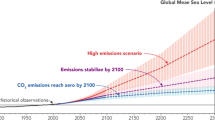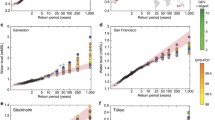Abstract
As the human society is facing potentially significant environmental impacts due to climate change, accurate impact assessments of sea level rise (SLR) are also critically needed. In this study, to conduct reliable SLR projection and inundation assessment, an integrated modeling framework is proposed and the application of this methodology is demonstrated for the State of Florida, USA. This framework utilizes a dynamic system model (DSM) with spatial analysis capability to predict the regional sea level change. The DSM projections are then used for geographic information system (GIS) based inundation analysis. Results show that the proposed methodology provides reliable inundation assessment for the likely scenario of spatially variable SLR over the 21st century and can be utilized in other coastal regions of the world to aid management decision in a timely manner.













Similar content being viewed by others
References
Aral MM (2013) Climate change and human population dynamics. J Water Qual Expo Health 5(4). Special issue on climate change. doi:10.1007/s12403-013-0091-5
Aral MM, Guan J, Chang B (2012) A dynamic system model to predict global sea-level rise and temperature change. J Hydrol Eng 17(2):237–242
Cabanes C, Huck T, Verdiere A (2006) Contribution of wind forcing and surface heating to interannual sea level variations in the Atlantic Ocean. J Phys Oceanogr 36(9):1739–1750
Chang B (2013) Spatial analysis of sea level rise associated with climate change. PhD dissertation, Georgia Institute of Technology, Atlanta, GA, USA
Chang B, Guan J, Aral MM (2013) A scientific discourse: climate change and sea level rise. J Hydrol Eng. doi:10.1061/(ASCE)HE.1943-5584.0000860
Church JA, White NJ, Coleman R, Lambeck K, Mitrovica JX (2004) Estimates of the regional distribution of sea level rise over the 1950–2000 period. J Climate 17(13):2609–2625
Cooper HM, Chen Q, Fletcher CH, Barbee MM (2013) Assessing vulnerability due to sea-level rise in Maui, Hawaii using LiDAR remote sensing and GIS. Clim Change 116(3–4):547–563
Cooper MJP, Beevers MD, Oppenheimer M (2008) The potential impacts of sea level rise on the coastal region of New Jersey, USA. Clim Change 90:475–492
CSIRO (2011) Sea level data. http://www.cmar.csiro.au/sealevel/sl_data_cmar.html. Accessed 8 April 2011
Dasgupta S, Laplante B, Meisner C, Wheeler D, Yan J (2009) The impact of sea level rise on developing countries: a comparative analysis. Clim Change 93:379–388
Gornitz V, Couch S, Hartig EK (2002) Impacts of sea level rise in the New York city metropolitan area. Glob Planet Change 32:61–88
Guan J, Chang B, Aral MM (2013) A dynamic control system model for global temperature change and sea level rise with CO2 emissions impact. Clim Res. doi:10.3354/cr01189
Hennecke WG, Greve CA, Cowell PJ, Thom BG (2004) GIS-based coastal behavior modeling and simulation of potential land and property loss: implications of sea-level rise at Collaroy/Narrabeen beach, Sydney (Australia). Coast Manag 32:449–470
Jones EG, Desmond GB, Henkle C, Glover R (2012) An approach to regional wetland digital elevation model development using a differential positioning system and a custom-built helicopter-based surveying system. Int J Remote Sens 33(2):450–465
Ledoux H, Gold C (2005) An efficient natural neighbour interpolation algorithm for geoscientific modeling. In: Fisher PF (ed) Developments in spatial data handling: 11th international symposium on spatial data handling. Springer, Berlin, pp 97–108
Li X, Rowley RJ, Kostelnick JC, Braaten D, Meisel J, Hulbutta K (2009) GIS analysis of global impacts from sea level rise. Photogramm Eng Remote Sens 75:807–818
Lichter M, Felsenstein D (2012) Assessing the costs of sea-level rise and extreme flooding at the local level: a GIS-based approach. Ocean Coast Manag 59:47–62
Meehl GA et al. (2007) Global climate projections. In: Solomon S et al. (eds) Climate change 2007: the physical science basis. Contribution of working group I to the fourth assessment report of the intergoverment panel on climate change. Cambridge University Press, Cambridge, pp 748–845
Mitrovica JX, Gomez N, Clark PU (2009) The sea-level fingerprint of West Antarctic collapse. Science 323(5915):753
Nicholls RJ et al. (2007) Coastal systems and low-lying areas. In: Parry ML et al. (eds) Climate change 2007: impacts, adaptation and vulnerability. Contribution of working group II to the fourth assessment report of the intergovernmental panel on climate change. Cambridge University Press, Cambridge, pp 316–357
NOAA Coastal Services Center (2010) Mapping inundation uncertainty. http://csc.noaa.gov/digitalcoast/_/pdf/ElevationMappingConfidence.pdf. Accessed 8 September 2010
NOAA (2011) Coastal and marine spatial planning data registry. http://egisws02.nos.noaa.gov/cmspgisdataregistry/. Accessed 9 December 2011
Pardaens AK, Lowe JA, Brown S, Nicholls RJ, de Gusmao D (2011) Sea-level rise and impacts projections under a future scenario with large greenhouse gas emission reductions. Geophys Res Lett 38(2):L12604
Parkinson RW, McCue T (2011) Assessing municipal vulnerability to predicted sea level rise: city of satellite beach, Florida. Clim Change 107:203–223
Smith TM, Reynolds RW, Peterson TC, Lawrimore J (2008) Improvements to NOAA’s historical merged land–ocean surface temperature analysis (1880–2006). J Climate 21:2283–2296
SOFIA (2012) Elevation data. http://sofia.usgs.gov/exchange/desmond/desmondelev.html. Accessed 22 January 2012
US Census Bureau (2010) Statistical abstract of the United States: 2010. US Government Printing Office, Washington
US Census Bureau (2012) Statistical abstract of the United States: 2012. US Government Printing Office, Washington
US Census Bureau (2013) TIGER/Line® shapefiles and TIGER/Line® files. http://www.census.gov/geo/maps-data/data/tiger-line.html. Accessed 15 March 2013
USGS (2013) The national map viewer. http://viewer.nationalmap.gov/viewer/. Accessed 6 January 2013
VDatum (2012) Vertical datum transformation. http://vdatum.noaa.gov. Accessed 20 January 2012
Wunsch C, Ponte RM, Heimbach P (2007) Decadal trends in sea level patterns: 1993–2004. J Climate 20(24):5889–5911
Yin J, Yin Z, Wang J, Xu S (2012) National assessment of coastal vulnerability to sea-level rise for the Chinese coast. J Coast Conserv 16:123–133
Zhang K (2011) Analysis of non-linear inundation from sea-level rise using LIDAR data: a case study for South Florida. Clim Change 106:537–565
Zhang K, Dittmar J, Ross M, Bergh C (2011) Assessment of sea level rise impacts on human population and real property in the Florida Keys. Clim Change 107:129–146
Author information
Authors and Affiliations
Corresponding author
Rights and permissions
About this article
Cite this article
Chang, B., Guan, J. & Aral, M.M. Modeling Spatial Variations of Sea Level Rise and Corresponding Inundation Impacts: A Case Study for Florida, USA. Water Qual Expo Health 6, 39–51 (2014). https://doi.org/10.1007/s12403-013-0099-x
Received:
Revised:
Accepted:
Published:
Issue Date:
DOI: https://doi.org/10.1007/s12403-013-0099-x




